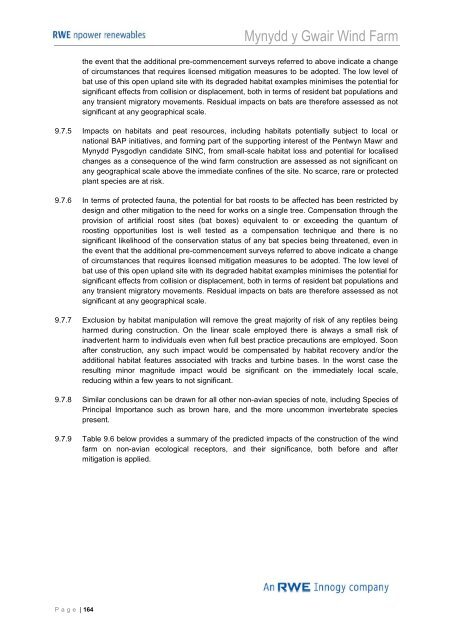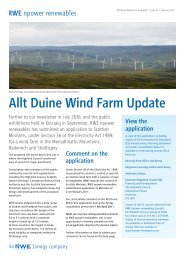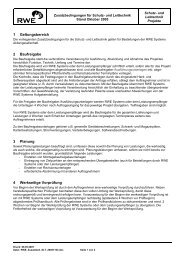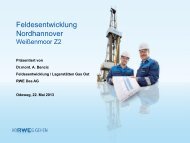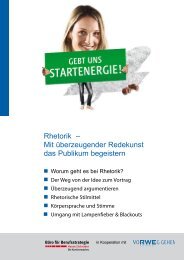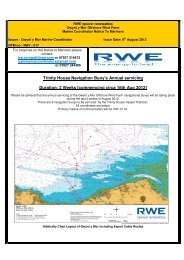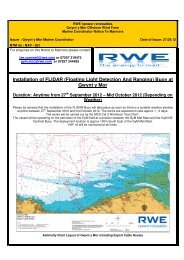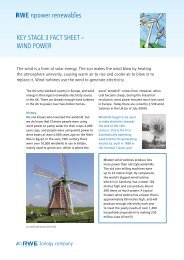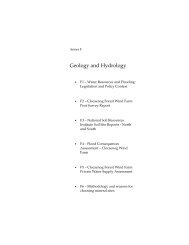Mynydd y Gwair Wind Farm - RWE.com
Mynydd y Gwair Wind Farm - RWE.com
Mynydd y Gwair Wind Farm - RWE.com
You also want an ePaper? Increase the reach of your titles
YUMPU automatically turns print PDFs into web optimized ePapers that Google loves.
P a g e | 164<br />
<strong>Mynydd</strong> y <strong>Gwair</strong> <strong>Wind</strong> <strong>Farm</strong><br />
the event that the additional pre-<strong>com</strong>mencement surveys referred to above indicate a change<br />
of circumstances that requires licensed mitigation measures to be adopted. The low level of<br />
bat use of this open upland site with its degraded habitat examples minimises the potential for<br />
significant effects from collision or displacement, both in terms of resident bat populations and<br />
any transient migratory movements. Residual impacts on bats are therefore assessed as not<br />
significant at any geographical scale.<br />
9.7.5 Impacts on habitats and peat resources, including habitats potentially subject to local or<br />
national BAP initiatives, and forming part of the supporting interest of the Pentwyn Mawr and<br />
<strong>Mynydd</strong> Pysgodlyn candidate SINC, from small-scale habitat loss and potential for localised<br />
changes as a consequence of the wind farm construction are assessed as not significant on<br />
any geographical scale above the immediate confines of the site. No scarce, rare or protected<br />
plant species are at risk.<br />
9.7.6 In terms of protected fauna, the potential for bat roosts to be affected has been restricted by<br />
design and other mitigation to the need for works on a single tree. Compensation through the<br />
provision of artificial roost sites (bat boxes) equivalent to or exceeding the quantum of<br />
roosting opportunities lost is well tested as a <strong>com</strong>pensation technique and there is no<br />
significant likelihood of the conservation status of any bat species being threatened, even in<br />
the event that the additional pre-<strong>com</strong>mencement surveys referred to above indicate a change<br />
of circumstances that requires licensed mitigation measures to be adopted. The low level of<br />
bat use of this open upland site with its degraded habitat examples minimises the potential for<br />
significant effects from collision or displacement, both in terms of resident bat populations and<br />
any transient migratory movements. Residual impacts on bats are therefore assessed as not<br />
significant at any geographical scale.<br />
9.7.7 Exclusion by habitat manipulation will remove the great majority of risk of any reptiles being<br />
harmed during construction. On the linear scale employed there is always a small risk of<br />
inadvertent harm to individuals even when full best practice precautions are employed. Soon<br />
after construction, any such impact would be <strong>com</strong>pensated by habitat recovery and/or the<br />
additional habitat features associated with tracks and turbine bases. In the worst case the<br />
resulting minor magnitude impact would be significant on the immediately local scale,<br />
reducing within a few years to not significant.<br />
9.7.8 Similar conclusions can be drawn for all other non-avian species of note, including Species of<br />
Principal Importance such as brown hare, and the more un<strong>com</strong>mon invertebrate species<br />
present.<br />
9.7.9 Table 9.6 below provides a summary of the predicted impacts of the construction of the wind<br />
farm on non-avian ecological receptors, and their significance, both before and after<br />
mitigation is applied.


